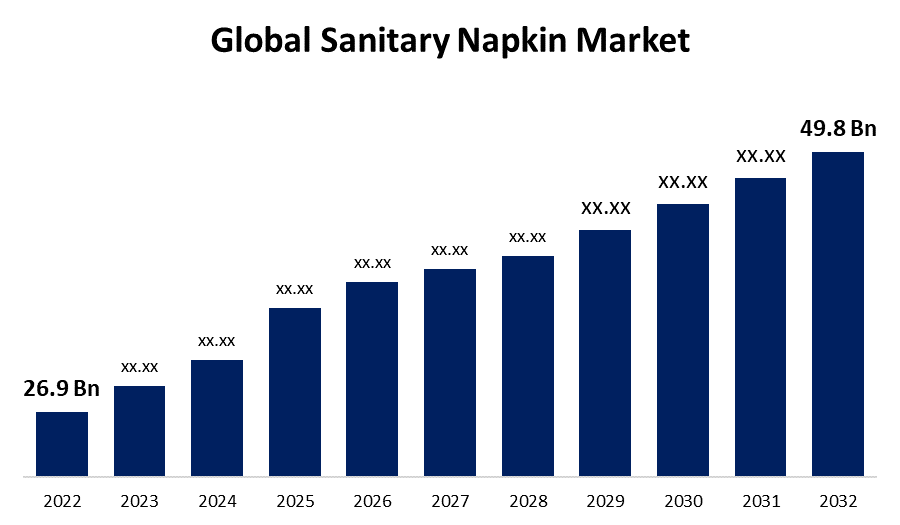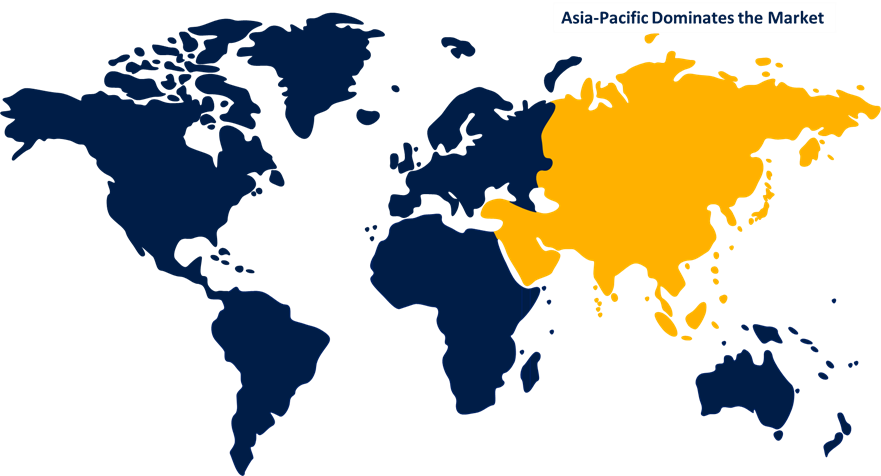Global Sanitary Napkin Market Size, Share, and COVID-19 Impact Analysis, By Tуре (Disposal Menstrual Napkins, Cloth Menstrual Napkins, Biodegradable Menstrual Napkins), By Material (Banana Fiber, Organic Cotton, Bamboo-Corn, Others), By Distribution Channel (Supermarkets and Hypermarkets, Pharmacies, Convenience Stores, Online, Specialty Stores, and Others), and By Region (North America, Europe, Asia-Pacific, Latin America, Middle East, and Africa), Analysis and Forecast 2022 – 2032
Industry: Consumer GoodsGlobal Sanitary Napkin Market Insights Forecasts to 2032
- The Global Sanitary Napkin Market Size was Valued at USD 26.9 Billion in 2022.
- The Market Size is Growing at a CAGR of 6.3% from 2022 to 2032
- The Worldwide Sanitary Napkin Market Size is Expected to Reach USD 49.8 Billion by 2032
- North America is expected to grow the fastest during the forecast period

Get more details on this report -
The Global Sanitary Napkin Market Size is Anticipated to Exceed USD 49.8 Billion by 2032, Growing at a CAGR of 6.3% from 2022 to 2032.
Market Overview
Sanitary napkins are absorbent materials that women and girls can use in their underwear during menstruation or in any other situation where it's vital to absorb blood flow from the vagina. The materials used to make menstrual pads vary based on the brand. The majority of sanitary napkins on the market are disposable, while others are disposable and designed for single use only. Reusable sanitary napkins, on the other hand, are fabric pads that may be repeatedly washed and used. Sanitary napkins are available in many forms and sizes, and their ability to absorb both heavy and light menstrual blood varies. Tampons and menstruation cups are worn inside the vagina; sanitary napkins, on the other hand, are worn externally. Sanitary napkins were traditionally composed of cotton and hydrophilic wood pulp. Superabsorbent fiber technology, which uses materials like cotton, cellulose, and polymers, is now used in the production of sanitary napkins due to technical advancements. Over time, a number of developments have been made, including panty liners, scented napkins, winged napkins, quilted fabric linings, and thinner pads. The fluid acquisition layer, the absorbent structure, the distribution component, and the liquid impermeable membrane are the four functional parts of a sanitary napkin. These napkins come in a variety of shapes and sizes, each with a unique absorption capacity.
Report Coverage
This research report categorizes the market for the global sanitary napkin market based on various segments and regions forecasts revenue growth and analyzes trends in each submarket. The report analyses the key growth drivers, opportunities, and challenges influencing the global sanitary napkin market. Recent market developments and competitive strategies such as expansion, product launch, and development, partnership, merger, and acquisition have been included to draw the competitive landscape in the market. The report strategically identifies and profiles the key market players and analyses their core competencies in each sub-segment of the global sanitary napkin market.
Global Sanitary Napkin Market Report Coverage
| Report Coverage | Details |
|---|---|
| Base Year: | 2022 |
| Market Size in 2022: | USD 26.9 Billion |
| Forecast Period: | 2022-2032 |
| Forecast Period CAGR 2022-2032 : | 6.3% |
| 2032 Value Projection: | USD 49.8 Billion |
| Historical Data for: | 2018-2021 |
| No. of Pages: | 200 |
| Tables, Charts & Figures: | 100 |
| Segments covered: | By Material, By Distribution Channel, By Region. |
| Companies covered:: | Procter and Gamble, Kao Corporation, The Edgewell Personal Care Company, Unicharm Corporation, Kimberly-Clark Corporation, Nobel Hygiene Pvt Ltd, Hengan International Group Company Limited, Ontex BV, Johnson and Johnson Services Ltd., Lil-Lets UK Limited, Johnson and Johnson, Others. |
| Pitfalls & Challenges: | COVID-19 Empact, Challenge, Future, Growth, & Analysis |
Get more details on this report -
Driving Factors
The global sanitary napkin market is being driven by rising individual income levels and growing women's knowledge of the advantages of maintaining hygiene during menstruation. In addition, a large number of NGOs are actively working to enhance women's health and hygiene, offer free sanitary products, and run educational campaigns on menstruation health. Additionally, a multitude of businesses are supplying a range of products to meet diverse needs, such as daytime and nighttime use, panty liners, and sizing variations, giving customers additional options. Additionally, the industry is expanding as a result of the major firms' growing investments in celebrity endorsements and advertising campaigns.
Restraining Factors
Dioxins, furans, plasticizers, and pesticides are just a few of the potentially dangerous synthetic chemicals included in a large number of chemical-based sanitation products in the market. Consumer surveys and recent scientific study confirm that using sanitary napkins often and for extended periods of time can lead to a number of ailments. These goods' chemical makeup can lead to cancer, reproductive system malfunction, and hormone imbalances.
Market Segmentation
The Global Sanitary Napkin Market share is classified into type, material, and distribution channel.
- The disposal menstrual napkins segment is expected to grow at the fastest pace in the global sanitary napkin market during the forecast period.
The sanitary napkin market is categorized by type into disposal menstrual napkins, cloth menstrual napkins, biodegradable menstrual napkins. Among these, the disposal menstrual napkins segment is expected to grow at the fastest pace in the sanitary napkin market during the forecast period. Because of the rising demand for disposable pads as a result of their accessibility and low cost. Moreover, some women's ignorance about biodegradable pads increases the need for disposable menstrual pads, which drives the growth of the market.
- The organic cotton segment is expected to grow at the highest pace in the global sanitary napkin market during the forecast period.
Based on the material, the global sanitary napkin market is divided into banana fiber, organic cotton, bamboo-corn, others. Among these, the organic cotton segment is expected to grow at the highest pace in the sanitary napkin market during the forecast period. The global market for sanitary napkins has grown as a result of the growing demand for organic sanitary napkins. There are no chemicals or potentially dangerous components in organic sanitary napkins because they are composed entirely of natural materials. These pads are safe for women to use, reusable, and kind to the environment. Because they are better for the environment and health, demand for organic sanitary pads is expected to rise in the coming years.
- The pharmacies segment is expected to hold the largest share of the global sanitary napkin market during the forecast period.
Based on the distribution channel, the global sanitary napkin market is divided into supermarkets and hypermarkets, pharmacies, convenience stores, online, specialty stores, and others. Among these, the pharmacies segment is expected to hold the largest share of the global sanitary napkin market during the forecast period. The accessibility and ubiquity of pharmacies are the primary factors propelling the expansion of this market. These shops are common in both rural and urban settings, giving customers in various places widespread access to sanitary napkins. To meet the varied needs of their customers, they offer a wide range of brands, sizes, and varieties. Additionally, the pharmacy's knowledgeable personnel improve the shopping experience by offering advice and product information.
Regional Segment Analysis of the Global Sanitary Napkin Market
- North America (U.S., Canada, Mexico)
- Europe (Germany, France, U.K., Italy, Spain, Rest of Europe)
- Asia-Pacific (China, Japan, India, Rest of APAC)
- South America (Brazil and the Rest of South America)
- The Middle East and Africa (UAE, South Africa, Rest of MEA)
Asia-Pacific is anticipated to hold the largest share of the global sanitary napkin market over the predicted timeframe.

Get more details on this report -
Asia-Pacific is projected to hold the largest share of the global sanitary napkin market over the predicted years. Significant innovation has been observed in the sanitary napkin market in the Asia Pacific region. In response to the changing needs of consumers, businesses have launched innovative and novel products. The increasing demand has led to the introduction of new organic and biodegradable sanitary napkins. The governments of the Asia-Pacific area promote sanitary napkins and menstrual hygiene. Menstrual hygiene and cleanliness are encouraged in India through the "Swachh Bharat Abhiyan" campaign. Demand for sanitary serviettes has grown, contributing to the market's expansion. The rise of sanitary serviette awareness and acceptability is attributed to a number of factors, including economic expansion, product development, innovation, and government support and initiatives. Future market expansion should be aided by these factors.
North America is expected to grow at the fastest pace in the global sanitary napkin market during the forecast period. The market is anticipated to be driven in the upcoming years by the introduction of organic products and the removal of chemicals from sanitary napkins. Because of increased product awareness, women's shifting attitudes about hygiene, and the accessibility of eco-friendly products, it is projected that this trend will continue. The market for sanitary napkins in North America was dominated by the United States. In North America, the market for sanitary napkins is being driven by convenience and comfort.
Competitive Analysis:
The report offers the appropriate analysis of the key organizations/companies involved within the global sanitary napkin along with a comparative evaluation primarily based on their product offering, business overviews, geographic presence, enterprise strategies, segment market share, and SWOT analysis. The report also provides an elaborative analysis focusing on the current news and developments of the companies, which includes product development, innovations, joint ventures, partnerships, mergers & acquisitions, strategic alliances, and others. This allows for the evaluation of the overall competition within the market.
List of Key Companies
- Procter and Gamble
- Kao Corporation
- The Edgewell Personal Care Company
- Unicharm Corporation
- Kimberly-Clark Corporation
- Nobel Hygiene Pvt Ltd
- Hengan International Group Company Limited
- Ontex BV
- Johnson and Johnson Services Ltd.
- Lil-Lets UK Limited
- Johnson and Johnson
- Others
Key Target Audience
- Market Players
- Investors
- End-users
- Government Authorities
- Consulting And Research Firm
- Venture capitalists
- Value-Added Resellers (VARs)
Recent Developments
- In June 2023, Niine Sanitary Napkins is the first company in India to introduce high-quality, reasonably priced biodegradable sanitary pads made of PLA.
- In January 2023, as part of its plan to improve brand reputation and accelerate brand growth in the region, Kimberly-Clark has introduced the Kortex ProHealth+ sanitary pad in India.
Market Segment
This study forecasts revenue at global, regional, and country levels from 2020 to 2032. Spherical Insights has segmented the Global Sanitary Napkin Market based on the below-mentioned segments:
Global Sanitary Napkin Market, By Material
- Banana Fiber
- Organic Cotton
- Bamboo-Corn
- Others
Global Sanitary Napkin Market, By Distribution Channel
- Supermarkets and Hypermarkets
- Pharmacies
- Convenience Stores
- Online
- Specialty Stores
- Others
Global Sanitary Napkin Market, By Region
- North America
- US
- Canada
- Mexico
- Europe
- Germany
- Uk
- France
- Italy
- Spain
- Russia
- Rest of Europe
- Asia Pacific
- China
- Japan
- India
- South Korea
- Australia
- Rest of Asia Pacific
- South America
- Brazil
- Argentina
- Rest of South America
- Middle East & Africa
- UAE
- Saudi Arabia
- Qatar
- South Africa
- Rest of the Middle East & Africa
Need help to buy this report?